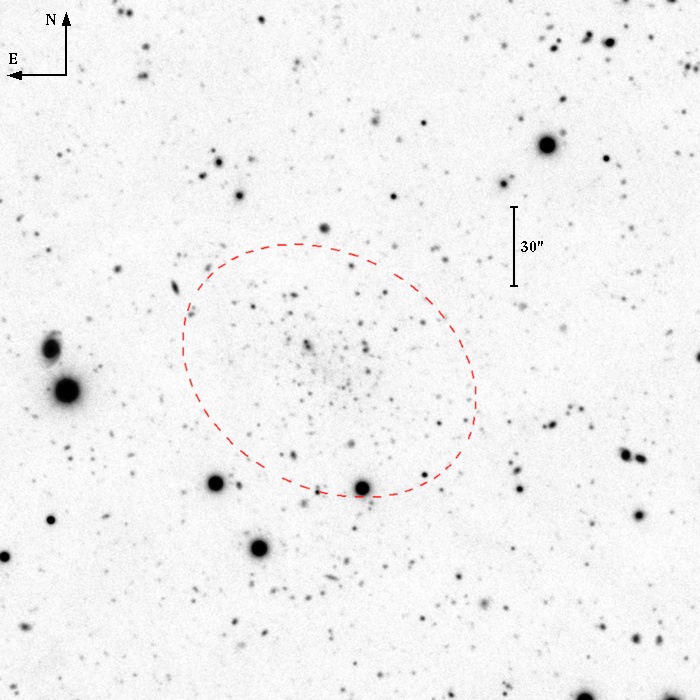Pisces VII/Triangulum III: a new dwarf galaxy of the Local Group and possible satellite of Messier 33 confirmed by DOLoRes@TNG
There is a new entry in the growing list of galaxies belonging to the Local Galaxy Group (LG), the system to which the Milky Way belongs. Named Pisces VII/Triangulum III, this new extended source was discovered in September 2020 by the amateur astronomer Giuseppe Donatiello by visual inspection of archival images of the DESI Legacy Imaging Surveys (DESI LIS) and subsequently confirmed by follow-up observations using the Italian Telescopio Nazionale Galileo (TNG).
The TNG imaging observations, in particular, were proposed by an international team involving researchers of several institutions: David Martinez-Delgado (principal investigator) and Emilio Alfaro (Instituto de Astrofisica de Andalucia), Walter Boschin (TNG), Giuseppe Donatiello (Unione Astrofili Italiani), Karim Noushin, Emily Charles and Michelle Collins (University of Surrey), Matteo Monelli (Instituto de Astrofisica de Canarias). Thanks to Director Discretionary Time awarded in November 2020, the object was observed for three hours with the instrument DOLoRes. Such a long total integration time was crucial to bring out this faint source against the sky background light. The images were reduced by Walter Boschin in real time, at the telescope, and showed that the source is a neighbouring, resolved dwarf galaxy (see Fig. 1).
With an angular size of about 1 arcmin, Pisces VII is located at a projected distance of about 70 kpc from the Messier 33 (M33) galaxy, the third largest LG member. The analysis of the color-magnitude diagram built from the TNG photometry allowed to estimate its distance, D~1.0 Mpc, and luminosity. The distance, linear size and photometric properties of this object suggest that it could be or an isolated ultra-faint dwarf galaxy of the LG or the second known satellite of M33.
Deeper data are needed to better constrain the precise distance
of such a faint source, but if Pisces VII can be confirmed as a true
satellite of M33 it is a significant finding.
In fact, M33 represents a clear example of what is known as the
missing satellites problem: according to simulations based
on the Lambda-CDM cosmological model such a massive galaxy should have
between nine and twenty-five satellite galaxies, but so far only one
potential satellite has been found.
This discrepancy, which does not occur for example in the similarly
massive Large Magellanic Cloud (another LG member and satellite of
the Milky Way), could be due to several reasons. Previous works have
suggested that, since M33 is gravitationally bound to the Andromeda
Galaxy (M31, the largest LG member), a past interaction may have
ejected most of its satellites. However, the orbital movements
indicate that M33 is in the process of its first fall towards M31,
so that the problem could imply a still incomplete knowledge of the
processes of galaxy formation or an observational bias, i.e. most of
M33 satellites could have luminosities and surface brightnesses that
lie just below the detection limits of previous surveys.
In this sense, the discovery of a new candidate satellite for M33
may change our understanding of the M31-M33 system and galaxy
formation, and for this reason it is important to carry out a census
of dwarf galaxies using the deepest possible data.
On the other hand, if Pisces VII is truely isolated it would be the
faintest known field dwarf galaxy discovered to date.
Deep images recently obtained by the Gemini North telescope will
allow the team to detect fainter stars in Pisces VII, which act as
more robust distance estimators since they have a known standard
brightness. It will also be important to confirm whether the
movement of this new galaxy is consistent with that of a dwarf
galaxy in the LG, for which spectroscopic observations with an eight
or ten-meter telescope will be crucial.
Whatever be the precise distance of Pisces VII, its detection by visual inspection of a limited area around M33 using the DESI LIS deep imaging suggests that there is still room for discovery of low surface brightness dwarf galaxies in the outskirts of the M31 - M33 system, beyond the bounds of previous surveys (like PAndAS) of this sky region.

Fig. 1: inverted g'-band image obtained with DOLoRes@TNG of the newly discovered ultra-faint dwarf galaxy Pisces VII/Triangulum III (Credits: W. Boschin/TNG).
More information in the accepted paper: Martinez Delgado, D.; Karim, N.; Charles, E. J. E.; Boschin, W.; et al., 2022, Monthly Notices of the Royal Astronomical Society, 509, 16 (ADS abstract)

